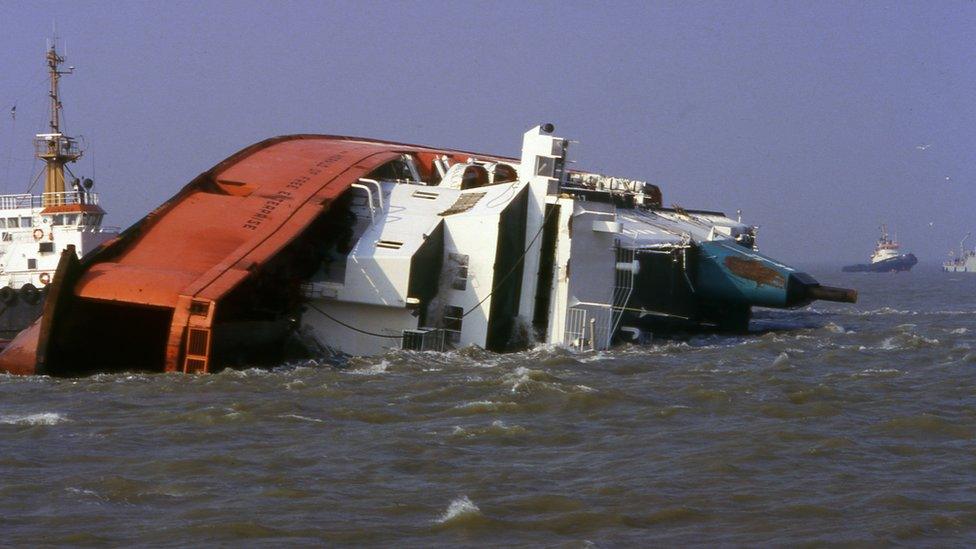Zeebrugge ferry disaster: Chaplain recalls 'traumatising' tragedy 30 years on
- Published

The Herald of Free Enterprise capsized just moments after pulling out of Zeebrugge
On 6 March 1987, passenger ferry the Herald of Free Enterprise pulled out of its berth at the Belgium port of Zeebrugge carrying 459 passengers and 80 crew.
Just minutes after leaving harbour, the ferry capsized. 193 people were killed in the tragedy.
Belfast man Bill McCrea was more than 150 miles away in Kent, when the ship began its final journey.
A chaplain for the Sailors' Society, Bill was on duty at the Merchant Navy and National Sea Training College in Gravesend.
Despite the distance, news of the tragedy travelled to the college fast.
"Our centre had younger trainee sailors coming through, and also older seafarers who were there to update their training.
"We had three men from the Herald at the centre that night who we had to try and comfort."

Bill McCrea knew many of the crew members on the ferry through his role as Sailors' Society chaplain
When Bill speaks, it's with a soft, instantly recognisable Belfast accent - a voice apparently unchanged by decades spent posted across the globe.
He grew up on the Donegall Road in the city and before entering the ministry, discovered an early love for the sea.
"I used to go down to the Belfast docks with my brothers and sisters to see the ships," he said. "I would say to them, 'look, see that ship? Someday I'll be a captain too'".
In the end, he took to the sea as a chaplain when he accepted the role with the Sailors' Society in 1969, a position he held until retirement in 2006.

Bill McCrea as a 16-year-old in Belfast
In that 37-year period, the Zeebrugge disaster would become "the most traumatising tragedy that ever happened in my life".
The disaster marked the beginning of months of shared grief and years of recovery, as signified by the annual remembrance service that continues with this week's 30th anniversary memorial.
After the incident, Bill travelled to Dover where he spent two weeks in the Sailors' Society's Seafarers' Centre, providing support to sailors and families alike.

What happened to the Herald of Free Enterprise?
The bow doors of the ferry were still open when it backed out of berth, with no indicator lights on the bridge to alert crew.
A large amount of water flooded into the car deck through the open bow doors, changing its centre of gravity.
The ferry capsized onto a sandbank, half-filled with water barely above freezing.
An inquiry named three crew members, including the captain, and Townsend Car Ferris Ltd, as responsible.
The disaster led directly to the formation of the UK's Marine Accident Investigation Branch, and the subsequent trial paved the way for the Corporate Manslaughter Act.

Bill often travelled to visit those grief stricken by what happened, and also conducted the funerals of four victims.
"The disaster and the subsequent weeks was a shock to my system. I have dealt with loss of life with seafarers' families over the years, but it was the enormity of this situation - so many people lost their lives that night."
One funeral the chaplain presided over was for a young man who he knew from the training centre - the Herald of Free Enterprise was his first posting as a sailor.
"It was his first assignment and he didn't come back. I visited his family and they were devastated.
"He had just finished his college course two weeks before. I knew him well."
It is 30 years since the Zeebrugge ferry capsized, killing 193 people
He continued: "The first month or so (after the disaster) was hard going. In their way, actually, the families were a big support to me.
"It can be difficult because families always react differently to your presence. Some are happy to have you, some will swear, some will be annoyed, some will be anti-God.
"In my case, most families needed help - not so much talking, just being there.
"The tragedy left people on their knees. The area of Dover was devastated, but the community came together in huge support.

The Zeebrugge ferry disaster was the site of heroism as well as tragedy
"I think that's what helped my visits. I was able to pray with the families, and not one refused a prayer."
Among the sadness and grief, there were unlikely tales of heroism too.
'Nightmare situation'
"I visited the wife of a man who died, she felt very guilty on top of everything else.
"She had talked her husband into the trip. When the boat capsized, they were trapped. It was actually incredibly hard to escape, particularly with a lifejacket, because you were trapped at the bottom of a boat that was on its side.
"She was trapped there and hypothermia set in, but there was a lorry driver beside her. He kept her alive by slapping her face and nipping her, to make sure she didn't fall asleep.
"It was a nightmare situation on board."
He said that surviving crew members attended funerals as part of their "shared grief".
A year on from the disaster, Bill led a memorial service at the request of the victims' families.
This began an annual service that the Sailors' Society has continued every year since.
"Each year we've held the service and families have come. About 10 years ago, the question was asked if the service should end but the families wanted it to continue.
"They've never really got over it completely.
"I've never really got over it myself."
- Published6 March 2012
